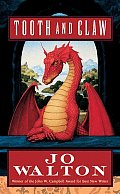
| Publisher: | Tor |
| Copyright: | November 2003 |
| Printing: | December 2004 |
| ISBN: | 0-765-34909-4 |
| Format: | Mass market |
| Pages: | 292 |
The patriarch of a gentle-born family is dying and has called his family to be near him. His eldest son has joined the Church as a parson and is well-settled and married; his eldest daughter has been married to a well-to-do lord (at the cost of a high dowry) and is protected and has already started having children. His younger three offspring, however, are not yet settled: his youngest son is trying to make his way in the difficult and not entirely respectable world of the city and commerce, and his two youngest daughters are yet maidens without firm marriage prospects.
The best he can do for his youngest children is to leave them nearly all his remaining hoard and other assets, and that's his intention as he dies. However, his son-in-law refuses to believe the patriarch's greatest asset would be part of such arrangements and insists on devouring much of his body himself, gaining the greatest length and health for his own family. The younger son is furious and vows revenge in court.
All of the players in this drama are dragons.
The brilliant conceit of Tooth and Claw is the casting of dragons into the roles of a typical 19th century comedy of manners while making many of the customs of that society biological imperatives. Dragon maidens are ruined for marriage by spending too much time unescorted near a male suiter: they blush from gold to pink, and there's nothing for it but to marry them immediately. Female dragons have no claws, leaving them somewhat defenseless but far more adept at letter-writing than males. Dragons amass treasure and give it in dowries, and then gather it in hoards and sleep on it (gold makes for a far more pleasant night). And in one of the sharpest satirical turns, dragon lords literally devour the peasants: dragon flesh is the only way for a dragon to grow and vital to surviving laying a clutch, and so the lords cull the weak and devour those who die of old age in their service, increasing their own strength.
The merger of the values of human high society and dragons works startlingly well and is full of brilliant analogies. Wing-binding, in particular, is a wonderful and multi-faceted symbol. Parsons of the Church bind their wings with a red cord and never fly as a sign of humility and sacrifice, and from that acquire immunity to challenge and combat. However, the wings of nearly all servants are also bound, preserving flight for the nobly-born and those select servants who serve as messengers. The political comparisons and social satire practically write themselves.
To this background Walton adds an engrossing plot, full of social peril, difficult relatives, hidden scandal, secrets, unwanted love affairs, romance, proposals, and the ever-constant worry of money. Most of the reviews make obvious comparisons with Jane Austen; Walton attributes her inspiration to Trollope. I personally don't know the details of 19th century literature well enough to make fine distinctions, but one gets an accurate feel for the tone. Walton doesn't hesitate to play it for comedy at times — all of the obsession with clothing goes into hats for dragons, which achieve Pompadourian levels of bizarre complexity — but most of the conventions are woven skillfully into aspects of dragon physiology or plausible social constructs for handling draconic concerns. In some cases, the social structures make more sense for dragons than they did for humans.
The basics and outcome of the plot will be familiar to any Austen reader, but the journey is a marvel and a delight. This is a wonderful balm after reading a serious and depressing novel: there are daring escapes and perils of family honor and reputation, villains brought to climatic justice, rewards for the characters one felt most sympathetic towards, and bits of adventure and star-crossed romance. The coincidences do pile on a bit heavily at the very end, but Walton creates delightful and sharp female characters despite their limited social context and it's worth some suspension of disbelief to reach the dramatically appropriate outcome.
This is great fun that is also worth re-reading to study the parallels with human society and the ways draconic characters cast matters in a new light. I particularly liked the treatment of class issues, which forms a small but significant subplot of the book and which makes vividly real some of the comments that are only metaphorical in our world. Also nicely handled is the schism of religions, which follows purely imaginary history and yet manages to echo Catholicism versus Protestant schisms surprisingly well. Digging into the possible comparisons can keep one occupied for some time.
Tooth and Claw is a great counterpoint to Naomi Novik's more recent Temeraire series and does for stories of women and society what Novik does for naval combat and the Napoleonic Wars, but (in my opinion) with even more depth and better pacing. Highly recommended. I hope we'll see further books written in the same universe.
Reviewed: 2007-10-21